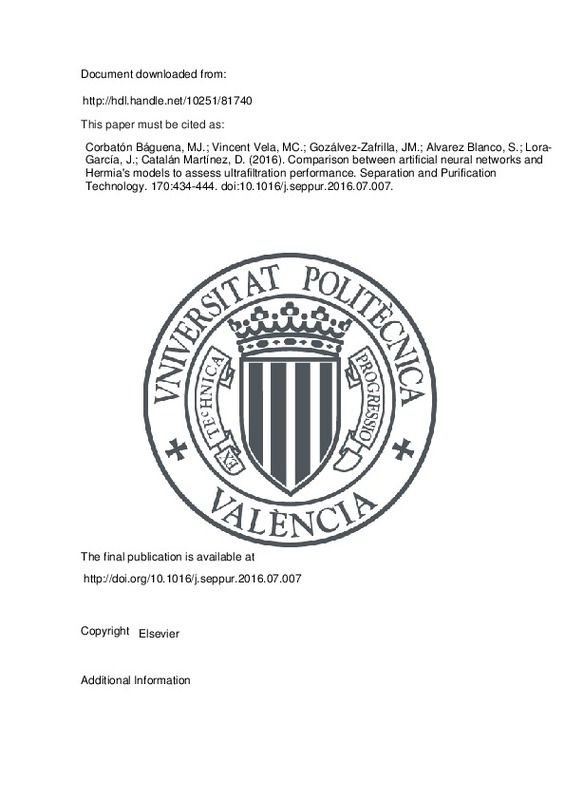JavaScript is disabled for your browser. Some features of this site may not work without it.
Buscar en RiuNet
Listar
Mi cuenta
Estadísticas
Ayuda RiuNet
Admin. UPV
Comparison between artificial neural networks and Hermia's models to assess ultrafiltration performance
Mostrar el registro sencillo del ítem
Ficheros en el ítem
| dc.contributor.author | Corbatón Báguena, María José
|
es_ES |
| dc.contributor.author | Vincent Vela, Maria Cinta
|
es_ES |
| dc.contributor.author | Gozálvez-Zafrilla, José M.
|
es_ES |
| dc.contributor.author | Alvarez Blanco, Silvia
|
es_ES |
| dc.contributor.author | Lora-García, Jaime
|
es_ES |
| dc.contributor.author | Catalán Martínez, David
|
es_ES |
| dc.date.accessioned | 2017-05-25T11:44:38Z | |
| dc.date.available | 2017-05-25T11:44:38Z | |
| dc.date.issued | 2016-10-01 | |
| dc.identifier.issn | 1383-5866 | |
| dc.identifier.uri | http://hdl.handle.net/10251/81740 | |
| dc.description.abstract | In this work, flux decline during crossflow ultrafiltration of macromolecules with ceramic membranes has been modeled using artificial neural networks. The artificial neural network tested was the multilayer perceptron. Operating parameters (transmembrane pressure, crossflow velocity and time) and dynamic fouling were used as inputs to predict the permeate flux. Several pretreatments of the experimental data and the optimal selection of the parameters of the neural networks were studied to improve the fitting accuracy. The fitting accuracy obtained with artificial neural networks was compared with Hermia pore blocking models adapted to crossflow ultrafiltration. The artificial neural networks generate simulations whose performance was comparable to that of Hermia's models adapted to crossflow ultrafiltration. Considering the computational speed, high accuracy and the ease of the artificial neural networks methodology, they are a competitive, powerful and fast alternative for dynamic crossflow ultrafiltration modeling. | es_ES |
| dc.description.sponsorship | The Spanish Ministry for Science and Innovation (Project OPTIMEM CTM2010-20248) is kindly acknowledged. | en_EN |
| dc.language | Inglés | es_ES |
| dc.publisher | Elsevier | es_ES |
| dc.relation.ispartof | Separation and Purification Technology | es_ES |
| dc.rights | Reserva de todos los derechos | es_ES |
| dc.subject | Artificial neural networks | es_ES |
| dc.subject | Crossflow ultrafiltration | es_ES |
| dc.subject | Fouling | es_ES |
| dc.subject | Modeling | es_ES |
| dc.subject.classification | INGENIERIA QUIMICA | es_ES |
| dc.title | Comparison between artificial neural networks and Hermia's models to assess ultrafiltration performance | es_ES |
| dc.type | Artículo | es_ES |
| dc.identifier.doi | 10.1016/j.seppur.2016.07.007 | |
| dc.relation.projectID | info:eu-repo/grantAgreement/MICINN//CTM2010-20248/ES/SIMULACION Y OPTIMIZACION MEDIANTE ALGORITMOS GENETICOS DE PROCESOS DE MEMBRANAS PARA EL TRATAMIENTO Y RECUPERACION DE AGUAS SALOBRES/ | es_ES |
| dc.rights.accessRights | Abierto | es_ES |
| dc.contributor.affiliation | Universitat Politècnica de València. Instituto de Seguridad Industrial, Radiofísica y Medioambiental - Institut de Seguretat Industrial, Radiofísica i Mediambiental | es_ES |
| dc.contributor.affiliation | Universitat Politècnica de València. Escuela Técnica Superior de Ingenieros Industriales - Escola Tècnica Superior d'Enginyers Industrials | es_ES |
| dc.contributor.affiliation | Universitat Politècnica de València. Escuela Politécnica Superior de Alcoy - Escola Politècnica Superior d'Alcoi | es_ES |
| dc.description.bibliographicCitation | Corbatón Báguena, MJ.; Vincent Vela, MC.; Gozálvez-Zafrilla, JM.; Alvarez Blanco, S.; Lora-García, J.; Catalán Martínez, D. (2016). Comparison between artificial neural networks and Hermia's models to assess ultrafiltration performance. Separation and Purification Technology. 170:434-444. https://doi.org/10.1016/j.seppur.2016.07.007 | es_ES |
| dc.description.accrualMethod | S | es_ES |
| dc.relation.publisherversion | http://doi.org/10.1016/j.seppur.2016.07.007 | es_ES |
| dc.description.upvformatpinicio | 434 | es_ES |
| dc.description.upvformatpfin | 444 | es_ES |
| dc.type.version | info:eu-repo/semantics/publishedVersion | es_ES |
| dc.description.volume | 170 | es_ES |
| dc.relation.senia | 315648 | es_ES |
| dc.identifier.eissn | 1873-3794 | |
| dc.contributor.funder | Ministerio de Ciencia e Innovación | es_ES |







![[Cerrado]](/themes/UPV/images/candado.png)

